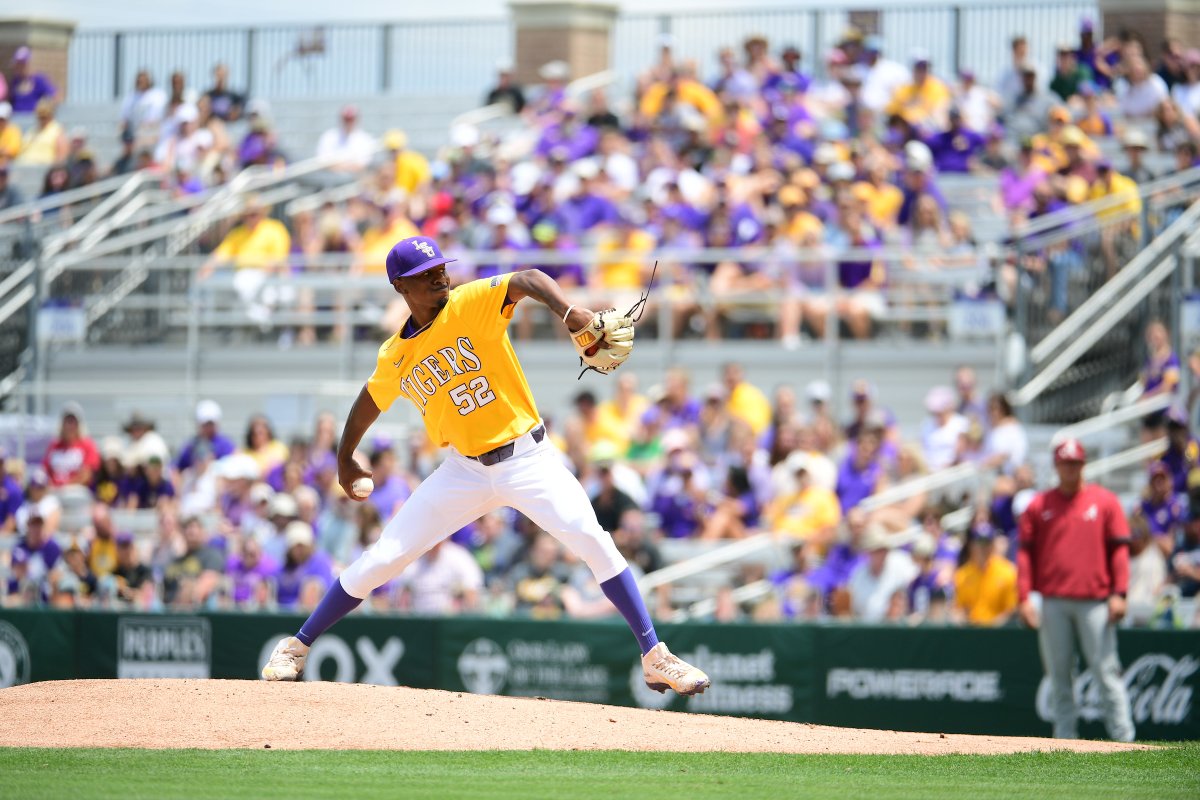
Apart from the new video board in right center field that will display a lineup full-time, most of the innovations the LSU baseball team will be invisible when 10,000+ fans fill into Alex Box Stadium Skip Bertman Field on Valentine’s Day for the 2020 season opener against Indiana.
But they’re there playing a big role.
“There’s an old saying,” LSU coach Paul Mainieri said. “You either adapt and grow or you grow old and get left behind. I grew up in the 60’s, played in the 70’s, and started coaching in the 80’s. And now we’re in the 2020’s. If you don’t adapt, learn, and keep moving with the times, you’ll get left behind. It’s just reality. And the reality is that there’s technology available now.”
In scrimmages, bullpen sessions, and general practices, each LSU pitcher wears a black compression sleeve over their throwing arm. On the inside elbow of that sleeve sits a sensor that tracks any metric you could possibly think of from the number of pitches thrown to the amount of torque they exert when pitching.
It’s called a Motus sleeve and it even accounts for the body’s total range of motion outside of the arm.
When practice concludes, the sensors upload data to a server where athletic trainer Cory Couture and pitching coach Alan Dunn view the crunched numbers. They get an idea of the day’s workload of each pitcher and what they can reasonably continue to do.
Ideally, it helps prevent injury by making sure that each player’s acute workload (the workload in a given week) doesn’t exceed their average workload (the workload in a given month), keeping them away from the dreaded arm soreness bug that plagued the 2019 season.
Another tool the pitchers have is the recently christened Aaron Nola Pitching Development Center.
It’s a section of the indoor batting cages that has been walled off and included a full bullpen mound and a high-speed camera. With the help of the camera, Dunn can not only tell a pitcher what they need to correct or work on with their delivery, but he can show them the correction.
“It’s tremendous,” sophomore pitcher Nick Storz said. “That pitching lab is huge, along with the Motus sleeves that we’ve been wearing. The combination of all that went a long way this year.
“You’re seeing the difference with everybody being healthy this fall. Everybody’s command of stuff is off the charts. The pitching lab has all the high technology things so you can make live adjustments if it’s a arm side issue or body positioning thing. So, that was big for every pitcher.”
Storz had made use of the lab when tweaking his slider grip, using to high-speed cameras to closely critique his own delivery.
“With all the cameras that they have in there that are in extreme slow-mo, I was able to see what my arm slot and hand placement was for my fastball and change-up was,” Storz said. “I’ve been working on that these past couple of weeks.”
Apart from the technological aspect of “the lab” as players call it, it’s also a great classroom. The walled-off environment ensures a one-on-one distraction free setting where Dunn can connect and have meaningful conversations with his pitchers.
“AD is amazing,” Storz said. “That guy is focused and his passion for pitching is off the charts. Being able to have some one-on-one time with him is tremendous for everybody.”
The Tigers’ hitters haven’t gotten left behind.
Mainieri revealed Thursday that a room in the batting cages was in the process of being converted into a virtual reality facility.
The idea is that composite footage of opposing pitchers along with pitch data could be compiled and uploaded to form a simulation of what each pitcher throws. The pitchers have a “bat” and while the technology can’t simulate contact, they can work on their timing against the pitches.
That essentially means that when Vanderbilt’s 2019 College World Series champion pitching ace Kumar Rocker comes to Baton Rouge on April 2, the Tigers will have already stood in the batter’s box and looked at his pitches.
Mainieri was skeptical of the technology until he tried it himself.
“Isn’t it the craziest thing you’ve ever heard,” Mainieri said. “When they came to me I was like, ‘please, come on. You’re kidding me.’
“And then I put the goggles and held the bat and thought it was the craziest thing I’ve ever seen. I stood in the batter’s box against Cole Henry and (Jack) Leftwich from Florida.”




Be the first to comment